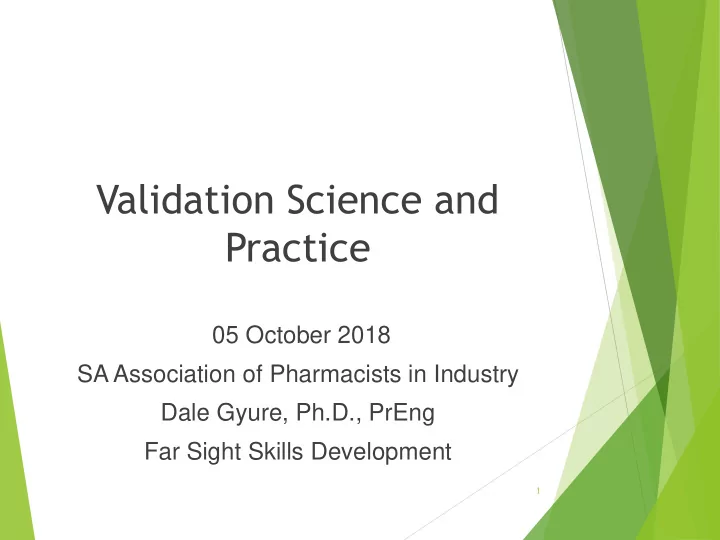

Validation Science and Practice 05 October 2018 SA Association of Pharmacists in Industry Dale Gyure, Ph.D., PrEng Far Sight Skills Development 1
Overview General Reminders Technical and Regulatory Points to Consider A Foray into Statistical Methods Wrap Up and Questions 2
General Reminders Our focus today on FDA’s 2011 Guidance Document – a “new” document The document itself reminds us of what regulators do (so well) The Guidance Document is not for medical devices and dietary supplements 3
(More) General Reminders In-process and final product checks offer limited assurance of quality The definition of validation has not changed The overarching claim remains the same 4
Technical / Regulatory Process Validation is aligned with the “life - cycle” of a process Quality / safety / efficacy to be built into the product by design The current focus is on variations, variations and variations 5
Technical / Regulatory Process Variations where they come from detecting and measuring them knowing their impact defining and implementing risk-based controls A remark concerning retrospective validation 6
Technical / Regulatory Process Validation takes place throughout the process life cycle 7
Technical / Regulatory Process Validation takes place throughout the process life cycle Stage 1 – Process Design 8
Technical / Regulatory Process Validation takes place throughout the process life cycle Stage 1 – Process Design Stage 2(a) – facility design 9
Technical / Regulatory Process Validation takes place throughout the process life cycle Stage 1 – Process Design Stage 2(a) – facility design - qualification 10
Technical / Regulatory Process Validation takes place throughout the process life cycle Stage 1 – Process Design Stage 2(a) – facility design - qualification Stage 2(b) – PPQ process performance qual 11
Technical / Regulatory Process Validation takes place throughout the process life cycle Stage 1 – Process Design Stage 2(a) – facility design - qualification Stage 2(b) – PPQ process performance qual Stage 3 – Ongoing verification 12
Metrics and Measurement Guidance on Process Performance Qualification is clear “ cumulative data from all relevant studies” “firms to employ statistical metrics” “performance indicators that allow risk- based decision-making such decision-making to be based on “ statistical methods ” “persons with adequate training in statistical process control” are recommended Still, industry interprets and regulators judge 13
Metrics and Measurement The Golden Rule of 3 PPQ batches no longer meets “c” GMP . Your approach to PPQ is based on residual risk – (not discussed today) We will wander into the topic of statistical process control. 14
Fun Forays into Statistics Process Capability and Process Capability Index ( C p ) and ( C p K ) Well established concepts in six-sigma school of thought Can be calculated – functions of specification limits (for you to say) and process wobble (goodness of control) The expectation is that your process runs between 1.0 and 1.6 Some perspective will be helpful 15
Fun Forays into Statistics Frequentist (or classical) statistics Remember mean and standard deviation are only estimates They are backward (or at best current) looking Limited assurance of future control hence not ideally suited for validation. 16
Fun Forays into Statistics Bayesian statistics Meet Thomas Bayes Probability is expressed as a future likelihood We all operate this way and it’s the basis for artificial intelligence Assurance (likelihood) of future control is based on an existing body of knowledge updated with new evidence. 17
Summary Points Validation Remains a Science / Discipline The life-cycle approach leads to a better understanding of the process An increasing level of rigor will be expected, but keep in mind the time constant for change Develop your internal regulatory strategy 18
Recommend
More recommend